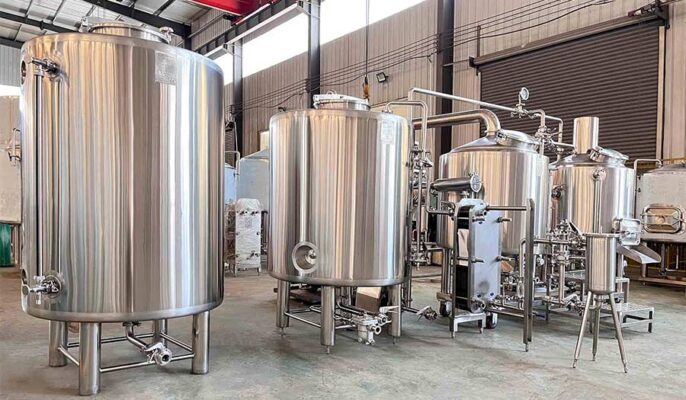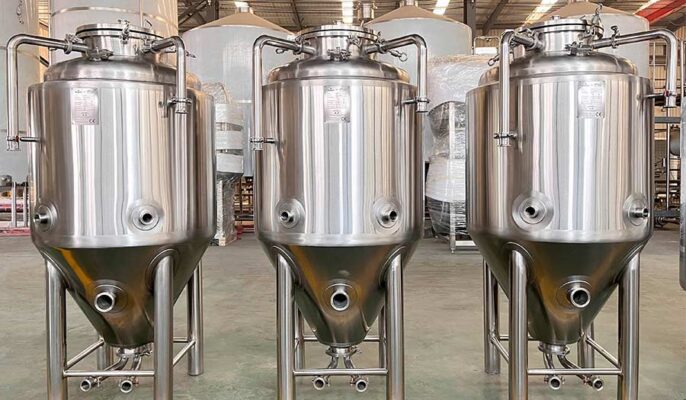Der Bau einer Nanobrauerei ist das ultimative Ziel eines Bierbrauers. Da Bierliebhaber immer mehr nach einzigartigem Geschmack und innovativen Aromen streben, haben sich auch Nanobrauereien als neues Modell für kleine Brauereien etabliert. Als Nanobrauereien werden in der Regel Brauereien mit sehr kleinen Produktionsmengen bezeichnet, in der Regel mit einer Produktionskapazität von einigen tausend bis zehntausend Litern pro Jahr. Der Vorteil dieser Kleinstbrauerei liegt in ihrer Flexibilität und hohen Prozesskontrolle, die es den Brauern ermöglicht, sich auf die Entwicklung einzigartiger Rezepte und Geschmacksrichtungen zu konzentrieren und gleichzeitig lokalisierte, maßgeschneiderte Bierprodukte anzubieten. In diesem Artikel wird erläutert, wie eine Nanobrauerei gebaut wird und welche Kosten sie verursacht.
Was ist eine Nanobrauerei?
Wie die Bezeichnung schon vermuten lässt, ist eine Nanobrauerei kleiner als eine Kleinstbrauerei und produziert viel weniger Bier pro Jahr. Eine einfache Definition für eine Nanobrauerei ist eine Brauerei oder ein Braupub, die/der weniger als 15.000 Fässer Bier pro Jahr herstellt. Die jährliche Produktionsgrenze für eine Nanobrauerei ist nicht auf dieselbe Weise definiert wie für andere Brauereien. Im Gegensatz zu Kleinstbrauereien gibt es keine eindeutige Anzahl von Fässern zur Unterscheidung zwischen Kleinstbrauereien und Nanobrauereien. Im Allgemeinen handelt es sich bei Nanobrauereien um kleine Betriebe, die in der Regel als Einzelunternehmen geführt werden.
Merkmale von Nanobrauereien:
- Produktion in kleinem Maßstab: Nanobrauereien haben in der Regel einen kleinen Produktionsumfang, der in der Regel zwischen einigen Tausend Litern und Zehntausenden Litern pro Jahr liegt. Dieses Produktionsmodell in kleinem Maßstab ermöglicht es den Brauereien, ihre Produktionspläne flexibler anzupassen und schnell auf Marktveränderungen und die Nachfrage der Verbraucher zu reagieren.
- Hohe Anpassungsfähigkeit: Aufgrund des geringen Produktionsumfangs können sich Nanobrauereien auf jeden einzelnen Sud konzentrieren und sehr individuelles Bier anbieten.
- Lokaler Betrieb: Nanobreweries hat sich dafür entschieden, auf dem lokalen Markt tätig zu sein, und verpflichtet sich, die umliegende Gemeinde und die lokalen Verbraucher zu bedienen.
- Innovative Entwicklung: Die Flexibilität von Nanobrauereien hat große Vorteile bei der Innovation, und die Brauer können verschiedene Braurezepte ausprobieren.

Was ist der Unterschied zwischen einer Nanobrauerei und einer Mikrobrauerei?
- Größenunterschied: Die für eine Nanobrauerei benötigte Ausrüstung ist in der Regel kleiner und kompakter, z. B. Sudkessel und Gärtanks mit einem Fassungsvermögen von nur wenigen hundert Litern. Mikrobrauereien benötigen größere Anlagen, z. B. Brausysteme mit einem Fassungsvermögen von mehreren tausend Litern bis zu mehr als zehntausend Litern, um größere Produktionsmengen zu bewältigen.
- Automatisierungsgrad: Nanobrauereien bevorzugen unter Umständen manuelle Arbeitsgänge und eine einfache Ausrüstung, und der Automatisierungsgrad der Anlagen ist gering. Im Gegensatz dazu benötigen Kleinstbrauereien oft ein höheres Maß an Automatisierungseinrichtungenwie z. B. automatisierte Brauereikontrollsysteme und effiziente Reinigungs-, Abfüll- und Verpackungsanlagen, um die Effizienz und Konsistenz der Produktion zu verbessern.
- Funktionen und Konfiguration: Die Ausrüstung einer Nanobrauerei kann mit Basisfunktionen ausgestattet sein, die den Anforderungen des manuellen Brauens entsprechen. Die Ausrüstung einer Mikrobrauerei erfordert komplexere Funktionen wie ein multifunktionales Brausystem, eine automatisierte Temperaturregelung und ein Gärungsmanagement sowie effizientere Filter- und Verpackungsanlagen.
- Kosten und Investitionen: Die Investitionen in die Ausrüstung einer Nanobrauerei sind in der Regel gering, und die Ausrüstungshersteller können maßgeschneiderte kleine Ausrüstungspakete zu einem relativ niedrigen Preis anbieten. Für Kleinstbrauereien sind größere Anlagen erforderlich, und die Anlagenhersteller müssen Systeme mit höheren Investitionen anbieten und benötigen möglicherweise zusätzliche technische Unterstützung und Wartungsdienste.
Wie man eine Nanobrauerei?
Einen Geschäftsplan aufstellen
Bevor Sie eine Nanobrauerei gründen, müssen Sie zunächst einen detaillierten Geschäftsplan erstellen. Dazu gehören Marktforschung, Zielkundengruppen, Wettbewerbsanalyse und Finanzprognosen. Das Verständnis der Bedürfnisse und Trends des Zielmarktes hilft bei der Entwicklung attraktiver Produkte.
Wählen Sie einen geeigneten Standort
Die Wahl eines geeigneten Standorts ist der Schlüssel zum Erfolg. Nanobrauereien benötigen in der Regel einen relativ kleinen Raum. Daher ist es entscheidend, einen Standort zu wählen, der den Produktionsanforderungen gerecht wird und über gute Transportmöglichkeiten verfügt.
Einholung der erforderlichen Genehmigungen
Um eine Brauerei zu gründen, müssen Sie verschiedene Genehmigungen und Lizenzen beantragen, darunter Produktions-, Gesundheits- und Verkaufsgenehmigungen. Achten Sie darauf, dass Sie die örtlichen Vorschriften und Anforderungen einhalten, um spätere rechtliche Probleme zu vermeiden.
Entwurf eines Produktionsprozesses
Entwickeln Sie einen detaillierten Produktionsprozess, der die Beschaffung von Rohstoffen, das Brauen, die Fermentierung und die Verpackung umfasst. Nanobrauereien sind in der Regel auf heikle Prozesse angewiesen, um die Produktqualität zu gewährleisten. Die Wahl der richtigen Ausrüstung und die Gestaltung eines angemessenen Produktionsprozesses sind entscheidend.

Kauf von Ausrüstung und Rohstoffen
Nanobrauereien benötigen hochwertige Brauereianlagen und Rohstoffe. Wählen Sie zuverlässige Lieferanten und stellen Sie sicher, dass die Geräte und Rohstoffe den Produktionsanforderungen entsprechen. Zur Ausrüstung gehören in der Regel Braukessel, GärbehälterFiltersysteme, und Abfüllanlagen.
Brausystem: Die Brauanlage ist das Herzstück Ihrer Brauerei, und es ist wichtig, dass Sie ein System wählen, das Ihren Bedürfnissen entspricht. Ein grundlegendes Brausystem sollte ein Würzefass, einen Läuterbottich und einen Sudkessel umfassen. Sie können auch Funktionen wie Heißbiertanks, Whirlpools oder Rücklauftanks hinzufügen, um Ihre Braufähigkeiten zu verbessern.
- Gärtanks: Sobald die Würze gebraut ist, muss sie gären, um Bier herzustellen. Gärtanks gibt es in verschiedenen Größen und Ausführungen, darunter offene und geschlossene Gärbehälter, Einzeltanks und durchsichtige Tanks. Es ist wichtig, einen Gärtank zu wählen, der die richtige Größe für Ihre Brauerei hat und über die von Ihnen benötigten Funktionen verfügt, z. B. Temperaturregelung und Druckablassventile.
- Helle Tanks: Sobald das Bier vergoren ist, wird es zur Klärung und Kohlensäurebildung in klare Tanks umgefüllt. Klare Tanks ähneln den Gärbehältern, sind aber für andere Zwecke konzipiert. Wie die Gärbehälter gibt es auch die Klarsichttanks in verschiedenen Größen und Ausführungen.
- Systeme zur Kühlung und Temperaturkontrolle: Die Temperaturkontrolle ist beim Bierbrauen von entscheidender Bedeutung, und es ist wichtig, ein System zu haben, das die richtige Temperatur während des gesamten Brau- und Gärprozesses aufrechterhalten kann. Das Kühlsystem kann Kältemaschinen, Wärmetauscher und Pumpen für die Zirkulation von Kühlmitteln umfassen.
- Qualitätskontrolle und Reinigungsgeräte: Die Aufrechterhaltung hoher Qualitätsstandards ist für eine erfolgreiche Brauerei von entscheidender Bedeutung. Dazu werden Geräte zur Qualitätskontrolle wie pH-Messgeräte, Messgeräte für gelösten Sauerstoff und Spektralphotometer benötigt. Auch Reinigungsgeräte sind wichtig, darunter Bürsten, Schläuche und Reinigungschemikalien.
Anwerbung und Ausbildung von Mitarbeitern
Die Einstellung erfahrener Mitarbeiter ist für die Bierherstellung unerlässlich. Die Mitarbeiter müssen entsprechend geschult werden, um sicherzustellen, dass sie den Brauprozess verstehen und die Anlagen effektiv bedienen können.
Markenbildung und Marketing
Der Aufbau eines starken Markenimages und Marketings ist der Schlüssel zur Gewinnung von Kunden. Entwerfen Sie ein einzigartiges Markenlogo und entwickeln Sie eine Marketingstrategie, einschließlich Werbung in sozialen Medien, Teilnahme an Bierausstellungen und Durchführung lokaler Veranstaltungen.
Überwachen und Optimieren der Produktion
Regelmäßige Überwachung des Produktionsprozesses und der Produktqualität und rechtzeitige Anpassung des Produktionsprozesses zur Verbesserung der Effizienz und der Produktqualität. Kontinuierliche Optimierung des Produktionsprozesses durch Feedback und Datenanalyse.
Vertriebskanäle einrichten
Bauen Sie eine Vielzahl von Vertriebskanälen auf, darunter lokale Bars, Restaurants, Supermärkte und Online-Verkaufsplattformen. Der Aufbau guter Kooperationsbeziehungen mit Distributoren und Einzelhändlern wird dazu beitragen, die Marktabdeckung zu erweitern.
Einhaltung von Rechts- und Sicherheitsstandards
Stellen Sie sicher, dass der Betrieb alle Sicherheits- und Rechtsstandards erfüllt, einschließlich Lebensmittelsicherheit und Sicherheit der Mitarbeiter. Dies trägt nicht nur zum Schutz der Mitarbeiter bei, sondern stärkt auch den Ruf der Marke und das Vertrauen der Verbraucher.
Wie wählt man Nano-Brauereianlagen aus?
Evaluieren Sie Ihren Braubedarf
Wählen Sie die richtige Nano-Brauanlage auf der Grundlage des erwarteten Produktionsvolumens. Nano-Brauereien benötigen in der Regel kleine Anlagen, und es ist entscheidend, ein System zu wählen, das den Produktionsanforderungen Ihrer Brauerei gerecht wird, also weder zu groß noch zu klein ist. Berücksichtigen Sie Ihr angestrebtes Produktionsvolumen und zukünftige Wachstumspläne, um die geeignete Kapazität für Ihre Brauerei zu bestimmen.
Auswahl der Ausrüstungsmaterialien
Die Materialien der Brauanlage spielen sowohl für die Qualität des Biers als auch für die Lebensdauer der Ausrüstung eine entscheidende Rolle. Edelstahl ist die häufigste Wahl, da er langlebig, korrosionsbeständig und leicht zu reinigen ist. Edelstahl gibt es in verschiedenen Qualitäten, z. B. 304 und 316, wobei 316 korrosionsbeständiger ist und sich daher besser für den langfristigen Einsatz eignet.
Heizmethoden
Es gibt drei Hauptbeheizungsmethoden für Brausysteme: direktes Feuer, Strom und Dampf. Jede Methode hat ihre Vor- und Nachteile, und die Wahl, die für Ihre Brauerei am besten geeignet ist, hängt von Faktoren wie Ihrem Budget, den verfügbaren Hilfsmitteln und den Platzverhältnissen ab. Informieren Sie sich über jede Option und wägen Sie die Vor- und Nachteile je nach Ihrer spezifischen Situation ab. Wenn Sie unsicher sind, können Sie sich auch an die micet-Gruppe wenden.
Kosten und Budget
Berücksichtigen Sie die Anschaffungskosten für das Gerät, einschließlich Versand-, Installations- und Inbetriebnahmekosten. Vergewissern Sie sich, dass die Gesamtkosten des Geräts in Ihr Budget passen. Informieren Sie sich über die Wartungs- und Betriebskosten Ihrer Anlage, einschließlich routinemäßiger Instandhaltung, Ersatzteilversorgung und Reparaturen. Wenn Sie sich für ein Gerät entscheiden, das einfach zu warten ist und dessen Reparaturkosten überschaubar sind, können Sie die langfristigen Betriebskosten senken.
Platzbedarf
Bei der Auswahl eines Nanobrewing-SystemBerücksichtigen Sie den verfügbaren Platz in Ihrer Brauerei. Vergewissern Sie sich, dass das von Ihnen gewählte System bequem in Ihre Anlage passt und gleichzeitig eine angemessene Belüftung, einen reibungslosen Arbeitsablauf sowie eine einfache Wartung und Reinigung ermöglicht. Es ist auch wichtig, für zukünftige Erweiterungen zu planen, da Ihre Brauerei mit der Zeit wachsen kann.
FAQ
Was ist eine Nanobrauerei?
Eine Nanobrauerei ist eine kleine Bierproduktionsanlage mit einem Jahresausstoß von mehreren tausend bis zehntausend Litern. Sie konzentrieren sich auf handwerkliches Brauen, hochgradig individualisierte und lokalisierte Märkte und bieten den Verbrauchern einzigartige und personalisierte Bierprodukte.
Welche Vorbereitungen sind erforderlich, um eine Nanobrauerei zu errichten?
- Marktforschung: Verstehen Sie die Bedürfnisse, Wettbewerber und Verbraucherpräferenzen des Zielmarktes.
- Geschäftsplan: Entwickeln Sie einen detaillierten Geschäftsplan, einschließlich Produktionsumfang, Finanzplan und Marketingstrategie.
- Auswahl des Standorts: Wählen Sie einen Standort, der für die Produktion und den Vertrieb geeignet ist und gleichzeitig die örtlichen Vorschriften und Geschäftsanforderungen erfüllt.
Welche Genehmigungen sind für die Errichtung einer Nanobrauerei erforderlich?
- Produktionslizenz: Offizielle Lizenz, die die Herstellung und den Verkauf von Bier erlaubt.
- Gesundheitliche Zulassung: Sicherstellen, dass die Produktionsumgebung den Gesundheits- und Sicherheitsstandards entspricht.
- Verkaufslizenz: Eine Lizenz, die den Verkauf von alkoholischen Getränken erlaubt.
- Umweltlizenz (falls zutreffend): Sicherstellung der Einhaltung von Umweltvorschriften.
Welche Faktoren sollten bei der Auswahl der Ausrüstung berücksichtigt werden?
- Produktionskapazität: Wählen Sie die Ausrüstung, die für das erwartete Produktionsvolumen geeignet ist.
- Konfiguration der Ausrüstung: Einschließlich der Funktionen und Spezifikationen von Braukesseln, Gärtanks, Filtersystemen und Verpackungsanlagen.
- Qualität und Haltbarkeit: Vergewissern Sie sich, dass die Geräte aus guten Materialien und in guter Verarbeitungsqualität hergestellt sind, um ihre Lebensdauer zu verlängern.
- Budget: Umfasst die Kosten für den Kauf, den Transport, die Installation und die Wartung der Ausrüstung.
- Technische Unterstützung: Wählen Sie einen Anbieter, der einen guten Kundendienst und technische Unterstützung bietet.




